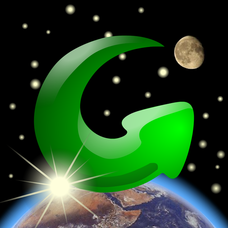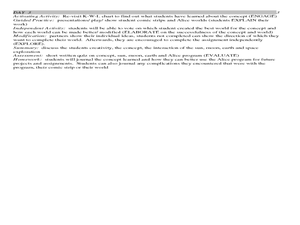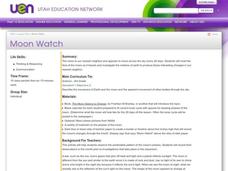GoSoftWorks
GoSkyWatch Planetarium for iPad - The Astronomy Star Guide
Digital compass alignment enables navigation of the skies with true orientation at any time. Just point to the sky or "aim for the stars!" This application acts as a virtual telescope, allowing you to zoom in on any object that is...
Curated OER
Facts and Myths about our Solar System
Sixth graders explore popular ideas about the Sun and Moon. In this space science lesson, 6th graders separate commonly accepted details about our solar system into facts and myths. Students research a particular idea and...
Curated OER
Moon Shadows
Students study the moon and its shadows. In this moon lesson students complete a lab activity that shows the different shadows and answer questions.
Curated OER
Moon Phases
For this moon worksheet, students fill in the different phases on the moon on a diagram and label each phase. Students compare a solar and lunar eclipse. This worksheet has 2 fill in the blank and 3 short answer questions.
Curated OER
A Lunar Transit of the Sun from Space
In this moon worksheet, students determine the angular size of the moon and draw a scaled model of the Earth, moon, and sun and given distances and positions. This worksheet has 4 problems to solve.
Curated OER
Moon Watch
Third graders read books about the moon and discuss its perceived changes as it moves across the sky. They observe the moon over the course of a month and chart their observations. They discuss their observations and conduct further...
Curated OER
Earth, Moon and Sun Assessment Test
In this space science activity, students answer 14 essay questions pertaining to the Earth, moon, and sun and their relationship. Prior knowledge is assumed, or this could be a pre-test.
Curated OER
How Distant Is The Moon?
Students discover how Aristarchus, a Greek astronomer around 230 BC, used a simple observation of the eclipse of the Moon, plus clever reasoning, to deduce the distance of the Moon. They practice the same calculation technique.
Curated OER
The Phases of the Moon
Students view an applet to study the phases of the Moon in relation to the orientation of the sun, moon, and Earth.
Curated OER
3rd Rock from the Sun's Baby Rock
Seventh graders have a chance to actively see each phase of the moon and make connections to what they see in the sky when you show how the moon goes through each of the phases.
Curated OER
Measuring the Sun's Diameter
Students project and measure the suns image using a refracting telescope. In this sun's diameter lesson students calculate the magnification of the telescope and determine the diameter if the Sun.
Curated OER
Moons
Students practice rote counting to 20. After a lecture about the planets and the moons that surround them, they identify the number of moons surrounding various planets. Students compare and contrast the quantity of moons surrounding...
Curated OER
Phases of the Moon
Sixth graders observe the changes in the moon's appearance over a two week period of time from their homes. They record and illustrate their observations and also complete daytime moon viewings as a class.
Curated OER
Wax On, Wane Off! the Different Views of the Moon
Students create a three-dimensional model of the Earth and Moon to show the different phases of the moon as they appear on Earth. In small groups, they draw a diagram for a phase, set up the model in the drawn positions then test it with...
Curated OER
May Earth be Revolving around the Sun?
Ninth graders explore how Aristarchus used the position of the half-full Moon to estimate the distance to the Sun, and how he made a great error, but still figured out that the Sun is much larger than Earth.
Curated OER
Once In a Blue Moon
Students review the characteristics of the planets and their moons. Using the internet, they research the relationship between the Earth and its moons. They take a template of the moon and draw craters of different colors to present to...
Curated OER
Moon Journal
Students review the planets and major moons in the Solar System. In groups, they research and describe the various phases of the moon. They record their observations of the moon phases over a specific period of time and use the...
Curated OER
Exploration of the Moon
For this moon worksheet, students review the Clementine exploration of the Earth's moon. This worksheet has 8 matching and 14 true or false questions.
Curated OER
Charting the Moon
Sixth graders observe changes in the moon's appearance over a month and keep records of their observations. They write a plan for recording what they see, and a paragraph reflecting on what they have learned over the course of the month.
Curated OER
Who Wants to be a Millionaire: Solar System
Fourth and fifth graders will love showing what they know about the planets and our solar system. This game is fashioned after "Who Wants to be a Millionaire" and has the class work through fifteen different solar system related...
Vosonos
Interactive Minds: Solar System
Travel through space as you learn about the galaxy, solar system, planets, and much more. An extensive resource for studying astronomy in upper-elementary and middle school classrooms.
NASA
When Do Lunar Eclipses Happen?
Who needs the daylight to simulate a lunar eclipse? Astronomers model the positions of the Sun, Earth, and Moon to explain the necessary conditions for a lunar eclipse. Investigators cut and label a paper plate to represent the Earth and...
Teach Engineering
An Inflated Impression of Mars
Help your class understand the magnitude of the distance between Earth and Mars with an activity that asks small groups to use balloons to create scale models of the Earth, Moon, and Mars. Class members figure out the distances...
Keep it Simple Science
The Earth in Space
Skim the surface of the earth with this brief, compact, summary of outer space. The sun, stars, galaxies, planets, and phases of the moon can be found in this all-in-one resource. Seventh graders will enjoy these simple worksheets to do...
Other popular searches
- Earth Moon Sun System
- Earth Sun and Moon
- Earth/sun/moon
- Sun and Moon Observations
- Sun Moon Earth
- Earth, Sun and Moon
- Space, Sun and Moon
- Earth and Moon and Sun
- Sun Moon Stars
- Moon, Sun and Stars























